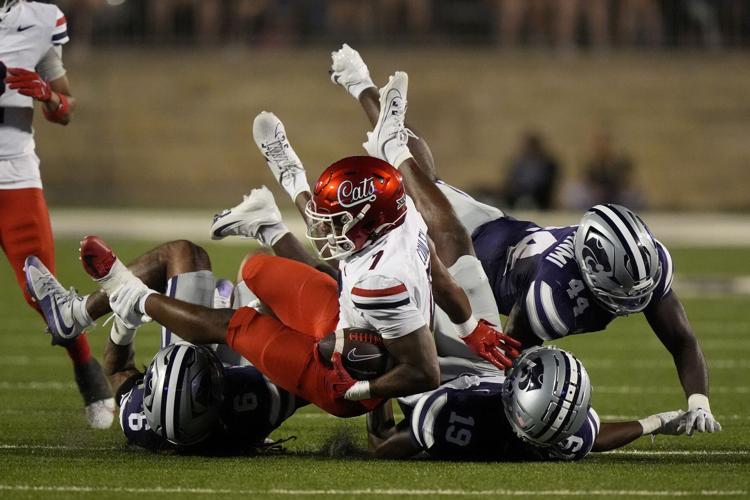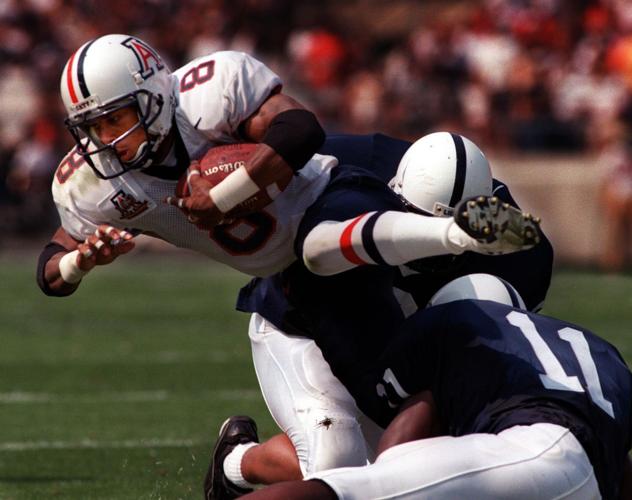Greg Hansen's Notebook: This entry is part of longtime Star columnist Greg Hansen's weekly notebook.
Subscribers can read this week's "Hansen's Notebook" in its entirety in the Sunday, Sept. 15, 2024, edition of the Arizona Daily Star (Page C2) — either in print or at Tucson.com/EEdition. Or, dig into the Hansen archives at Tucson.com/Hansen.

is the longtime sports columnist for the
Arizona Daily Starand
Tucson.com.
Arizona lost its 500th game in football history Friday at Kansas State, which, when put in perspective, isn’t such a bad thing: KSU has lost 624, along with Big 12 foes Oklahoma State (535), Baylor (594) and Iowa State (670).
What was humbling about the 31-7 blowout was that it compares closely to Arizona’s career loss No. 335 more than any in memory.

In the 1999 season opener, Penn State dominated Arizona from the start and led 31-0 at halftime.
That was late August 1999, when the No. 4 Wildcats got too big for their britches just as they agreed to play No. 3 Penn State at Happy Valley. Coming off a 12-1 season, expectations in Tucson were in orbit.

Arizona running back Quali Conley (7) is tackled by Kansas State safety Jordan Riley (6), safety VJ Payne (19) and defensive end Tobi Osunsanmi (44) during the first half Friday in Manhattan, Kansas.
Alas, the Nittany Lions won 41-7, and Dick Tomey’s program was never the same. They limped home at 6-6 that season, setting the stage for the coach’s dismissal a year later.
What was overlooked was that Arizona was missing star-caliber players Chris McAlister, Edwin Mulitalo, Jeremy McDaniel, Yusuf Scott and Daniel Greer, among others, from ’98.
Many UA fans now fail to comprehend that personnel losses from Jedd Fisch’s 10-3 team a year ago are almost impossible to repair in eight months. Gone are Jordan Morgan, Tanner McLaughlin, Jacob Cowing, Jonah Coleman, Michael Wiley, Bill Norton, Ephesians Prysock, Martell Irby, Taylor Upshaw and Raymond Pulido, among others.
Maybe Oregon or Texas can replace 10 elite contributors like those in a brief offseason, but Arizona has rarely done so.
Friday’s game at KSU’s Snyder Family Stadium was also a first look at what life on the Big 12 road will be like — rowdy, start-to-finish noise in front of a sellout crowd. It’s so different than Arizona’s life on the Pac-12 road.
It was KSU’s 22nd sellout since 2013. KSU has averaged 97% capacity at home games in that span. By comparison, Arizona played in front of just 21 Pac-12 sellouts from 2000-23 (not counting UA-ASU games).
Road games now take on a fully different meaning for Arizona. In the minutes before Friday’s game at KSU, 100 Harley Davidson motorcycles were allowed inside Snyder Stadium, circling the field, drumming their engines, stoking the sellout crowd.
Can you imagine UCLA allowing a tour of Harley Davidson’s inside the keep-the-noise-down Rose Bowl?
After due research, I discovered some of the numbers that exhibit just how “easy’’ Arizona had it on the Pac-12 road from 1978-2023.
• Stanford averaged just 34,510 for 15 home games against Arizona. Capacity at Stanford ranged from 80,000 to 50,000, for a much-needed downsizing 10 years ago. Sellouts: None, with the largest crowd 48,204 in 2012.
• Cal averaged just 37,533 for 17 home games against Arizona. Capacity at Memorial Stadium was 75,000 until a down-sizing to 63,000 a few years ago. Sellouts: None, with the largest crowd 56,021 in 2007.
• UCLA averaged just 56,444 for 16 games against UCLA at the Rose Bowl, capacity ranging from 103,000 to a recent downsizing of 89,702. Largest crowd: 81,673 in 2012.
Even Arizona’s trips to USC were met with empty seats galore. In 20 games at the LA Coliseum, Arizona drew as few as 49,342, and just one near-capacity crowd, 90,221, in 2005, when USC was ranked No. 1. Average crowd over all those years: 65,361, or roughly 25,000 empty seats per game.
By comparison, every Big 12 school except West Virginia drew more than 93% capacity last season; West Virginia opened this season by drawing 62,084 at Milan Puskar Stadium, which has a listed capacity of 60,000.
And one more thing: of all the concerning statistics compiled by Arizona through three games — notably allowing 518 rushing yards and committing 207 yards of penalties — the most sobering is that the Wildcats drew just 44,748 and 47,746 for its opening home games against New Mexico and NAU.
Those numbers were surely padded. In-house attendance at both games looked much closer to 40,000.
As much as it is on Arizona’s coaching staff to recruit better players to avoid clunky losses like those at KSU, and unimpressive victories over New Mexico and NAU, it’s on Tucsonans to step up and support the Wildcats the way those in central Kansas support the KSU Wildcats.
This isn’t the Pac-12 anymore.
Pertinent storylines, statistics, quotes and more from No. 20 Arizona's blowout loss to 14th-ranked Kansas State in Manhattan.
Breaking down the UA’s disappointing performance in the Little Apple, including the defense’s struggles against Avery Johnson, an offense that’s suddenly one-dimensional, Arizona’s penalty problem and more.
The grades are in for the Arizona Wildcats’ 31-7 loss to Kansas State on Friday night. After checking out our grades and comments, try our int…
No. 20 Arizona suffers its first loss of the Brent Brennan era after 14th-ranked Kansas State runs all over the UA.
Photos: No. 14 Kansas State runs over No. 20 Arizona 31-7, college football

Kansas State running back DJ Giddens (31) is pushed into the end zone to score a touchdown during the second half.

Kansas State quarterback Avery Johnson gets past Arizona defensive lineman Dominic Lolesio, left, during the second half of their Sept. 13 matchup in Manhattan, Kansas.

Arizona’s defense tries unsuccessfully to stop a 1-yard run by Kansas State quarterback Avery Johnson for a first down on Sept. 13.

Kansas State wide receiver Dante Cephas drops a pass during the first half of an NCAA college football game against Arizona Friday, Sept. 13, 2024, in Manhattan, Kan. (AP Photo/Charlie Riedel)

Kansas State tight end Will Swanson, left, celebrates with quarterback Avery Johnson (2) after scoring a touchdown during the first half of an NCAA college football game against Arizona Friday, Sept. 13, 2024, in Manhattan, Kan. (AP Photo/Charlie Riedel)

Arizona quarterback Noah Fifita (11) looks to pass under pressure from Kansas State linebacker Austin Moore (41) during the first half of an NCAA college football game Friday, Sept. 13, 2024, in Manhattan, Kan. (AP Photo/Charlie Riedel)

Kansas State running back DJ Giddens, center is pushed into the end zone to score a touchdown during the second half of KSU’s game against Arizona on Friday.

Kansas State quarterback Avery Johnson throws during the first half of an NCAA college football game against Arizona Friday, Sept. 13, 2024, in Manhattan, Kan. (AP Photo/Charlie Riedel)

Arizona running back Quali Conley, right, celebrates after scoring an early touchdown at against Kansas State Friday in Manhattan, Kansas.

Arizona running back Quali Conley falls into the end zone to score a touchdown during the first half. The Wildcats went up 7-0 on their first drive of the game but were outscored 31-0 after that.

Arizona running back Quali Conley (7) dives over Kansas State safety Marques Sigle (21) to score a touchdown during the first half of an NCAA college football game Friday, Sept. 13, 2024, in Manhattan, Kan. (AP Photo/Charlie Riedel)

Arizona wide receiver Tetairoa McMillan, right, tries to get past Kansas State cornerback Keenan Garber during the first half of the host Wildcats’ 31-7 win.

Arizona quarterback Noah Fifita passes the ball during the first half of an NCAA college football game against Kansas State Friday, Sept. 13, 2024, in Manhattan, Kan. (AP Photo/Charlie Riedel)

Arizona quarterback Noah Fifita looks to pass during the first half of the UA’s 31-7 loss at Kansas State Friday in Manhattan, Kansas.

Arizona head coach Brent Brennan watches during the first half of Friday’s loss at Kansas State. UA is 2-1 through his first three games as coach. “We’ve had moments of really good football in all three phases, then we’ve had moments of not great football,” Brennan said.

Arizona head coach Brent Brennan watches during the first half against Kansas State Friday, Sept. 13, 2024, in Manhattan, Kan.

Arizona tight end Sam Olson falls out of bounds after getting a first down during the first half of the loss to Kansas State on Sept. 13.

Arizona tight end Sam Olson catches a pass for a first down during the first half of the game at Kansas State on Sept. 13.

Arizona quarterback Noah Fifita passes around Kansas State defensive end Cody Stufflebean (47) during the first half of an NCAA college football game Friday, Sept. 13, 2024, in Manhattan, Kan. (AP Photo/Charlie Riedel)

Arizona quarterback Noah Fifita passes around Kansas State defensive end Cody Stufflebean (47) during the first half KSU’s 31-7 win over the UA Friday in Manhattan, Kansas.

Arizona quarterback Noah Fifita looks to pass under pressure from Kansas State linebacker Austin Moore during the first half Friday. UA is off this week before taking on No. 12 Utah in Salt Lake City on Sept. 28.

Arizona quarterback Noah Fifita (11) looks to pass under pressure from Kansas State linebacker Austin Moore (41) during the first half of an NCAA college football game Friday, Sept. 13, 2024, in Manhattan, Kan. (AP Photo/Charlie Riedel)

Arizona running back Quali Conley is tackled by Kansas State linebacker Desmond Purnell during the first half of K-State's 31-7 win Friday.

Arizona wide receiver Montana Lemonious-Craig falls after catching a pass out of bounds during the first half.

Arizona running back Quali Conley (7) is tackled by Kansas State safety Jordan Riley (6), safety VJ Payne (19) and defensive end Tobi Osunsanmi (44) during the first half of an NCAA college football game Friday, Sept. 13, 2024, in Manhattan, Kan. (AP Photo/Charlie Riedel)

Kansas State quarterback Avery Johnson passes during the first half of an NCAA college football game against Arizona Friday, Sept. 13, 2024, in Manhattan, Kan. (AP Photo/Charlie Riedel)

Kansas State quarterback Avery Johnson (2) runs the ball during the first half of an NCAA college football game against Arizona Friday, Sept. 13, 2024, in Manhattan, Kan. (AP Photo/Charlie Riedel)

Kansas State place kicker Chris Tennant (17) trips over Arizona defensive back Genesis Smith after kicking a field goal during the second half of an NCAA college football game Friday, Sept. 13, 2024, in Manhattan, Kan. (AP Photo/Charlie Riedel)

Kansas State head coach Chris Klieman watches during the second half of an NCAA college football game against Arizona Friday, Sept. 13, 2024, in Manhattan, Kan. (AP Photo/Charlie Riedel)

Kansas State wide receiver Dante Cephas drops a pass during the first half of an NCAA college football game against Arizona Friday, Sept. 13, 2024, in Manhattan, Kan. (AP Photo/Charlie Riedel)

Kansas State quarterback Avery Johnson runs the ball during the second half of an NCAA college football game against Arizona Friday, Sept. 13, 2024, in Manhattan, Kan. (AP Photo/Charlie Riedel)

Kansas State place kicker Chris Tennant (17) kicks a field goal during the second half of an NCAA college football game against Arizona Friday, Sept. 13, 2024, in Manhattan, Kan. (AP Photo/Charlie Riedel)









